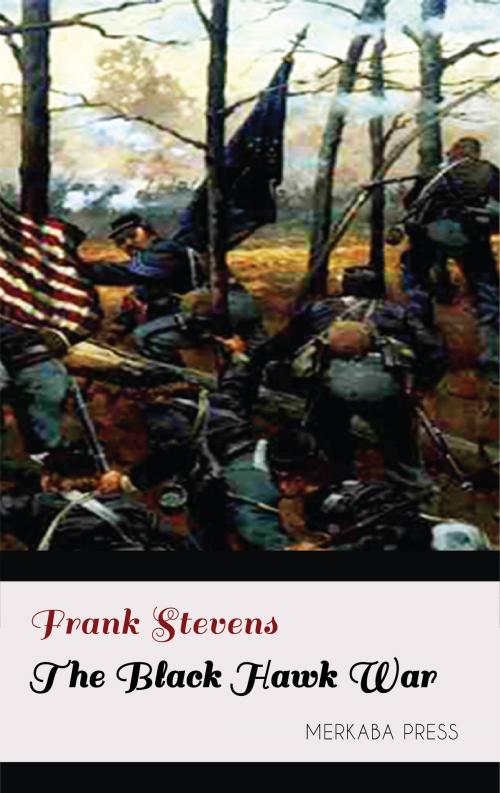| Author: | Frank Stevens | ISBN: | 6610000019960 |
| Publisher: | PublishDrive | Publication: | July 11, 2017 |
| Imprint: | Merkaba Press | Language: | English |
| Author: | Frank Stevens |
| ISBN: | 6610000019960 |
| Publisher: | PublishDrive |
| Publication: | July 11, 2017 |
| Imprint: | Merkaba Press |
| Language: | English |
Black Hawk’s name, as given in his autobiography, was Ma-ka-tai-she-kia-kiak, and, without reference to the many renditions of it by various writers, is the version that will be adopted in this work as nearest authentic. He was born in the year 1767 at the Sac or Sauk village, located on the north bank of Rock River in the State of Illinois, about three miles above its confluence with the Mississippi. His father, Py-e-sa, a grandson of Na-na-ma-kee or Thunder (a descendant of other Thunders), was born near Montreal, Canada, where the Great Spirit was reputed in Indian lore to have first placed the great Sac nation. Black Hawk was a full blood Sac, five feet eleven inches tall in his moccasins; of broad but meager build and capable of great endurance. His features were pinched and drawn, giving unusual prominence to the cheek bones and a Roman nose, itself pronounced. The chin was sharp. The mouth was full and inclined to remain open in repose. His eyes were bright, black and restless, glistening as they roamed during a conversation. Above these rested no eyebrows. The forehead was given the appearance of unusual fullness and height from the fact that all hair was plucked from the scalp, with the single exception of the scalp lock, to which, on occasions of state, was fastened a bunch of eagle feathers. In his later years it was his boast that he had worn the lock with such prominence to tempt an enemy to fight for it and to facilitate its removal should he be slain in the encounter. This statement, however, must be received as a boast and nothing more, because among the Sacs the custom of plucking from the scalp all hairs save the scalp lock was general and not confined to Black Hawk’s redoubtable person, as he would have us believe. J.C. Beltrami, the Italian traveler, who ascended the Mississippi in 1823, stopping at all the Indian villages, particularly Black Hawk’s upon Rock River, which he reached May 10th, has this to say, which is interesting: “The faces of the Saukees, although exhibiting features characteristic of their savage state, are not disagreeable, and they are rather well made than otherwise. Their size and structure, which are of the middle kind, indicate neither peculiar strength nor weakness. Their heads are rather small; that part called by French anatomists voute orbitaire has in general no hair except a small tuft upon the pineal gland, like that of the Turks; this gives the forehead an appearance of great elevation. Their eyes are small and their eyebrows thin; the cornea approaches rather to yellow, the pupil to red; they are the link between those of the orang-outang and ours. Their ears are sufficiently large to bear all the jewels, etc., with which they are adorned; two foxes’ tails dangled from those of the Great Eagle. I have seen others to which were hung bells, heads of birds and dozens of buckles, which penetrated the whole cartilaginous part from top to bottom. Their noses are large and flat, like those of the nations of eastern Asia; their nostrils are pierced and ornamented like their ears. The maxillary bones, or pommettes, are very prominent. The under jaw extends outwards on both sides. Their mouths are rather large; their teeth close set, and of the finest enamel; their lips a little inverted. Their necks are regularly formed; they have large bellies and narrow chests, so that their bodies are generally larger below than above. Their feet and hands are well proportioned. Except the tuft on the head, which we have already remarked, they have no hair on any part of the body. Books which deal greatly in the marvelous convert this into an extraordinary phenomenon, but the fact is that, from a superstition common to all savages, they pluck it out, and, as they begin at an early age and use the most perservering means for its extirpation, nothing is left but a soft down.”
Black Hawk’s name, as given in his autobiography, was Ma-ka-tai-she-kia-kiak, and, without reference to the many renditions of it by various writers, is the version that will be adopted in this work as nearest authentic. He was born in the year 1767 at the Sac or Sauk village, located on the north bank of Rock River in the State of Illinois, about three miles above its confluence with the Mississippi. His father, Py-e-sa, a grandson of Na-na-ma-kee or Thunder (a descendant of other Thunders), was born near Montreal, Canada, where the Great Spirit was reputed in Indian lore to have first placed the great Sac nation. Black Hawk was a full blood Sac, five feet eleven inches tall in his moccasins; of broad but meager build and capable of great endurance. His features were pinched and drawn, giving unusual prominence to the cheek bones and a Roman nose, itself pronounced. The chin was sharp. The mouth was full and inclined to remain open in repose. His eyes were bright, black and restless, glistening as they roamed during a conversation. Above these rested no eyebrows. The forehead was given the appearance of unusual fullness and height from the fact that all hair was plucked from the scalp, with the single exception of the scalp lock, to which, on occasions of state, was fastened a bunch of eagle feathers. In his later years it was his boast that he had worn the lock with such prominence to tempt an enemy to fight for it and to facilitate its removal should he be slain in the encounter. This statement, however, must be received as a boast and nothing more, because among the Sacs the custom of plucking from the scalp all hairs save the scalp lock was general and not confined to Black Hawk’s redoubtable person, as he would have us believe. J.C. Beltrami, the Italian traveler, who ascended the Mississippi in 1823, stopping at all the Indian villages, particularly Black Hawk’s upon Rock River, which he reached May 10th, has this to say, which is interesting: “The faces of the Saukees, although exhibiting features characteristic of their savage state, are not disagreeable, and they are rather well made than otherwise. Their size and structure, which are of the middle kind, indicate neither peculiar strength nor weakness. Their heads are rather small; that part called by French anatomists voute orbitaire has in general no hair except a small tuft upon the pineal gland, like that of the Turks; this gives the forehead an appearance of great elevation. Their eyes are small and their eyebrows thin; the cornea approaches rather to yellow, the pupil to red; they are the link between those of the orang-outang and ours. Their ears are sufficiently large to bear all the jewels, etc., with which they are adorned; two foxes’ tails dangled from those of the Great Eagle. I have seen others to which were hung bells, heads of birds and dozens of buckles, which penetrated the whole cartilaginous part from top to bottom. Their noses are large and flat, like those of the nations of eastern Asia; their nostrils are pierced and ornamented like their ears. The maxillary bones, or pommettes, are very prominent. The under jaw extends outwards on both sides. Their mouths are rather large; their teeth close set, and of the finest enamel; their lips a little inverted. Their necks are regularly formed; they have large bellies and narrow chests, so that their bodies are generally larger below than above. Their feet and hands are well proportioned. Except the tuft on the head, which we have already remarked, they have no hair on any part of the body. Books which deal greatly in the marvelous convert this into an extraordinary phenomenon, but the fact is that, from a superstition common to all savages, they pluck it out, and, as they begin at an early age and use the most perservering means for its extirpation, nothing is left but a soft down.”















